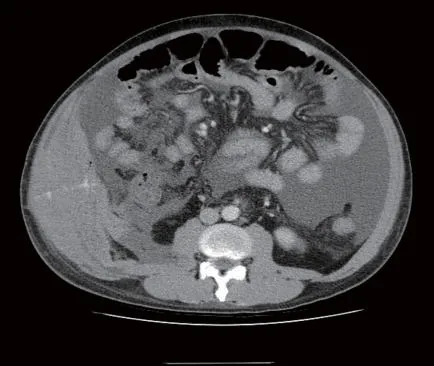A deadly needle-tract: Inward exsanguination
Chin-shen Lin, Chi-wei Lee
1 Department of Emergency Medicine, Kaohsiung Medical University Hospital, Kaohsiung 807, Taiwan, China
2 Research Center for Environmental Medicine, Kaohsiung Medical University, Kaohsiung 807, Taiwan, China
A 41-year-old male with liver cirrhosis suffered from abdominal fullness due to massive ascites. A 16-gauge needle catheter was inserted by Z-tract techniqueinto the right lower quadrant, and 3,000 mL of strawcolored ascites was drained. A pressure bandage was applied. There was no evidence of bleeding. The patient tolerated the procedure well and was discharged stable(blood pressure 124/72 mmHg [1 mmHg=0.133 kPa];pulse rate 83 beats/minute). It was observed that the patient suffered from right lower quadrant pain and cold sweating when he revisited the emergency department at 13 hours after he was discharged. He was afebrile.
Reassessment revealed right lower quadrant tenderness. Neither leukocytosis nor elevation of C-reactive protein was noted. His blood pressure dropped to 93/52 mmHg with a compensatory pulse rate above 100 beats/minute. His hemoglobin dropped drastically from 9.2 g/dL to 4.7 g/dL within 13 hours.He denied hematemesis or hematochezia. Prothrombin time was prolonged with an international normalized ratio of 2.5. Abdominal computed tomography (CT)disclosed an abdominal wall hematoma with contrast medium leaking into a transmural needle-tract (Figure 1). Hemoperitoneum was confirmed by diagnostic fine-needle paracentesis. His condition was eventually stabilized after aggressive fluid resuscitation and blood transfusion.

Figure 1. Contrast medium extravasation into a needle-tract after abdominal paracentesis (arrow).
Although paracentesis is considered a relatively safe procedure,abdominal wall hematomas occur in less than 2% of punctures, and significant bleeding in less than 0.2%.A reasonable length of time for close observation of hemodynamic changes after the procedure, instead of a prompt discharge, is a simple safeguarded measure for early detection of occult hemorrhage.
None.
Not needed.
The authors have no competing interests relevant to the present study.
CSL wrote the study. All authors read and approved the f inal manuscript.
